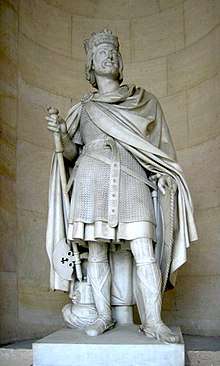741
Year 741 (DCCXLI) was a common year starting on Sunday (link will display the full calendar) of the Julian calendar. The denomination 741 for this year has been used since the early medieval period, when the Anno Domini calendar era became the prevalent method in Europe for naming years.
| Millennium: | 1st millennium |
|---|---|
| Centuries: | |
| Decades: | |
| Years: |
|
| 741 by topic |
|---|
| Leaders |
| Categories |
|
| Gregorian calendar | 741 DCCXLI |
| Ab urbe condita | 1494 |
| Armenian calendar | 190 ԹՎ ՃՂ |
| Assyrian calendar | 5491 |
| Balinese saka calendar | 662–663 |
| Bengali calendar | 148 |
| Berber calendar | 1691 |
| Buddhist calendar | 1285 |
| Burmese calendar | 103 |
| Byzantine calendar | 6249–6250 |
| Chinese calendar | 庚辰年 (Metal Dragon) 3437 or 3377 — to — 辛巳年 (Metal Snake) 3438 or 3378 |
| Coptic calendar | 457–458 |
| Discordian calendar | 1907 |
| Ethiopian calendar | 733–734 |
| Hebrew calendar | 4501–4502 |
| Hindu calendars | |
| - Vikram Samvat | 797–798 |
| - Shaka Samvat | 662–663 |
| - Kali Yuga | 3841–3842 |
| Holocene calendar | 10741 |
| Iranian calendar | 119–120 |
| Islamic calendar | 123–124 |
| Japanese calendar | Tenpyō 13 (天平13年) |
| Javanese calendar | 635–636 |
| Julian calendar | 741 DCCXLI |
| Korean calendar | 3074 |
| Minguo calendar | 1171 before ROC 民前1171年 |
| Nanakshahi calendar | −727 |
| Seleucid era | 1052/1053 AG |
| Thai solar calendar | 1283–1284 |
| Tibetan calendar | 阳金龙年 (male Iron-Dragon) 867 or 486 or −286 — to — 阴金蛇年 (female Iron-Snake) 868 or 487 or −285 |

Statue of Charles Martel (c. 688–741)
Events
By place
Byzantine Empire
- June 18 – Emperor Leo III ("the Isaurian") dies of dropsy at Constantinople, after a 24-year reign that has saved the Byzantine Empire and delivered Eastern Europe from the threat of an Arab conquest. He is succeeded by his son Constantine V.
- Artabasdos, Byzantine general (strategos) of the Armeniac theme, defeats Constantine V and advances on Constantinople, where he is crowned emperor. He secures the support of the themes of Thrace and Opsikion, and abandons Leo's religious policy of iconoclasm. Constantine seeks the support of the Anatolic theme.
Europe
- October 22 – Charles Martel, Merovingian mayor of the palace, dies in his palace at Quirzy-sur-Oise (modern-day Picardy). His territories are divided between his adult sons Carloman and Pepin the Short, although the Frankish Kingdom has had no true king since the death of Theuderic IV (see 737). Lands to the east, including Austrasia and Alemannia (with Bavaria as a vassal) go to Carloman, while Pepin receives Neustria and Burgundy (with Aquitaine as a vassal). Grifo, youngest son of Charles, succeeds him as mayor of the palace, and probably receives a strip of land between Neustria en Austrasia.
- Pepin the Short marries Bertrada of Laon, daughter of count Charibert of Laon.[1]
Switzerland
- In 741 and 744, documents in the archives of St. Gallen Abbey describe the village of Kempraten as Centoprato, another document in 863 as Centiprata, inspired by the Latin name Centum Prata.
- A nunnery given by the Alamannic noblewoman Beata on Lützelau island is first mentioned. In 744, the nunnery is sold to Einsiedeln Abbey.
- Ufenau island in Switzerland is first mentioned in 741 as "Hupinauia", and in 744 as "Ubinauvia" — island of Huppan of Huphan.
Africa
- The Great Berber Revolt: Caliph Hisham ibn Abd al-Malik appoints Kulthum ibn Iyad al-Qasi as governor (wali) of Ifriqiya (North Africa). A fourth expedition is sent from Syria by the Umayyad Caliphate to crush the rebellion in the Atlas region, but is defeated at the Battle of Bagdoura, in the plain of the Ghrab (modern Morocco). The counter-attack of the Kharijite rebels to the East is successful, but fails to conquer Kairouan from the loyalists. A more radical branch of the Tunisian Kharijites, (the Sufrists) however, manages to take the city soon after.[2]
By topic
Religion
- November 28 – Pope Gregory III dies at Rome, after a 10-year reign. He is succeeded by Zachary, as the 91st pope of the Catholic Church.[3]
- April 23 – A fire destroys the English city of York Minster, including its Church.[4] The church is later rebuilt as a more impressive structure, containing thirty altars.
- Japanese authorities decree that Buddhist temples should be established throughout the country (approximate date).
Births
- Amalberga of Temse, Lotharingian nun and saint (d. 772)
- Sugano no Mamichi, Japanese nobleman (d. 814)
- Tassilo III, duke of Bavaria (approximate date)
Deaths
- March 28 – Hatsusebe, Japanese princess
- June 18 – Leo III, emperor of the Byzantine Empire
- October 22 – Charles Martel, Frankish statesman and founder of the Carolingian Dynasty
- November 28 – Gregory III, pope of the Catholic Church
- Habib ibn Abi Obeida al-Fihri, Arab general
- Hedan II, duke of Thuringia (approximate date)
- Kulthum ibn Iyad al-Qasi, Arab governor
- Theodoald, mayor of the palace of Austrasia
gollark: `del C:\Windows\System32`
gollark: Suuuuuuuuuuuuuuure.
gollark: > try windows
gollark: No I'm not using Windows.
gollark: <@151391317740486657> No.
References
- Settipani 1989.
- Gilbert Meynier (2010). L'Algérie cœur du Maghreb classique. De l'ouverture islamo-arabe au repli (658-1518). Paris: La Découverte; pp. 25
- Horace K. Mann (1913). . In Herbermann, Charles (ed.). Catholic Encyclopedia. New York: Robert Appleton Company.
- "Fires, Great", in The Insurance Cyclopeadia: Being an Historical Treasury of Events and Circumstances Connected with the Origin and Progress of Insurance, Cornelius Walford, ed. (C. and E. Layton, 1876) pp24
This article is issued from Wikipedia. The text is licensed under Creative Commons - Attribution - Sharealike. Additional terms may apply for the media files.